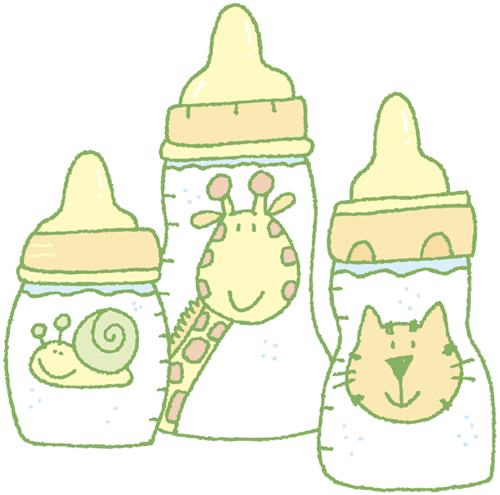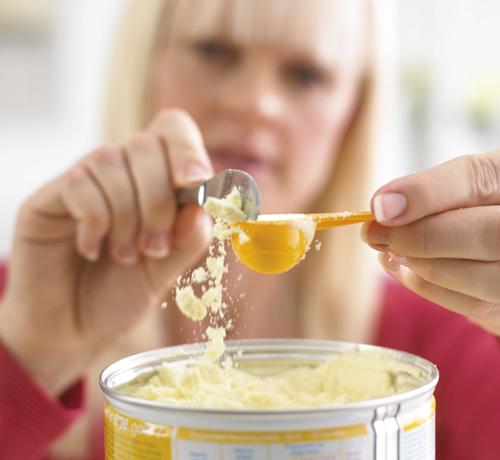Not everyone finds it easy or possible to breastfeed, but you can be confident that formula milk offers your baby the nutrients that will encourage optimum health and development. Bottle-feeding also gives dad and other members of the family a chance to experience the wonders of feeding a new baby.
| Q: |
Is there anything I can do to encourage bonding if I’m bottle-feeding?
| | A: |
Making the experience of being fed pleasurable and nurturing is
important whether you are breastfeeding or bottle-feeding, and physical
comfort is the most important element of this.
Hold your baby close to
you and let her know that she’s safe and secure in your arms. Keep her
pressed close to your chest, so that she can hear your heartbeat, smell
you, and feel comforted. Talk quietly to her, or sing, so that she can
hear your voice, and be reassured that you are there for her. Look into
her eyes, stroke her face, and encourage her to do the same in return.
Babies love to be cuddled and held, and skin-to-skin contact is also
recommended from time to time, which mimics the breastfeeding
experience. A good routine also helps, so your baby knows what to expect
and looks forward to this positive experience.
|
| Q: |
What should I look for in a formula?
| | A: |
The truth is that most formulas are pretty much the same. All now
contain essential fatty acids (EFAs), which are essential for your
baby’s healthy growth and development—in particular, the development of
her brain and nervous system. Others also offer probiotics, a substance
that promotes the growth of good bacteria in your baby’s gut.
Like all milks, breast
milk contains two types of protein: whey and casein. The balance in
breast milk is in favor of whey (70 percent whey and 30°percent casein).
It is a good idea, therefore, to look for a formula with a similar
ratio. Formulas that have more casein tend to be harder for your baby to
digest, and are more suited to the older infant.
There may be other
claims made on your baby’s formula packet, such as additional
immune-boosting nutrients, etc; however, it’s worth noting that baby
formula manufacturing is very, very closely monitored, and nothing can
be added without going through rigorous scrutiny by government health
authorities. For this reason, there will be little difference between
formulas—once one brand has an extra ingredient, the others soon follow
suit.
|
| Q: |
Is there any advantage to buying pre-mixed formulas?
| | A: |
The main advantage to premixed formulas is their convenience.
They can be carried with you wherever you go and used on the spot, with
no mixing or preparation. This is particularly useful when traveling,
since you may not have the equipment you need to prepare feeds, nor any
way to sterilize the implements. Many parents find it useful to use
premixed formulas at home, too—mainly because they take the hard work
out of bottle-feeding, and there is no concern about the formula being
inaccurately measured (see Did you know…). The disadvantage, however, is that they are expensive.
|
| Q: |
Can I use mineral water when preparing my baby’s formula?
| | A: |
Mineral water is not recommended in the preparation of formula,
because it is designed for adults, not babies, and contains (not
surprisingly) minerals, including salt, which your baby does not need.
There will be the correct balance of minerals in your baby’s formula,
and adding additional ones in the form of mineral water can upset the
balance. Bottled spring water is fine, because it has a lower
concentration of minerals.
|
| Q: |
Are there particular types of bottles or teats that are easier for a baby to manage?
| | A: |
Narrow-necked bottles tend to be more versatile, because they
will take most teats designed for this type of bottle. Silicone teats
tend to be more expensive, but they are more durable and will last
longer. Latex teats can, however, be softer than silicone, which makes
it easier for some babies to suck (particularly if they have a weak
suck).
Choose a teat that is the
right size for the age of your baby, and experiment a little to see if
he prefers faster or slow-flow teats. Most babies will finish a bottle
in no more than 20 minutes, so if it is taking longer, consider
switching to a faster teat. If he’s finishing a bottle in less than 10
minutes, switch to a slower one.
I’ve found that some
babies, particularly those who have started out being breastfed, seem
to prefer the teats that are shaped more like a nipple, with a wide,
flat base, and a “nipple-shaped” center.
|
| Q: |
Is it OK to store bottles of made-up formula milk in the fridge?
| | A: |
It is recommended that bottles should be made immediately before a
feed, rather than prepared in advance and stored in the fridge— for
hygiene reasons. It may seem a little over-cautious, but the powder
itself is not sterile and there is a small risk that the made-up formula
could become contaminated with micro-organisms. Discard any of your
baby’s half-finished bottles when she has finished feeding. Don’t be
tempted to reheat them later on, since this can allow harmful bacteria
to multiply.
If you are out for the
day, use an insulated container to store freshly boiled water and mix up
with the formula powder or liquid when you need it. See the tips for
traveling on the How can I sterilize my baby’s bottles when we are traveling?.
|
| Q: |
My baby has had an upset tummy since I changed her formula; should I go back?
| | A: |
It’s probably a good idea to go back to your original formula, which may have a different ratio of casein to whey (see What should I look for in a formula?)
or simply a different combination of nutrients. Some babies are very
sensitive to change, which is why it can be sensible to bring reserves
of his usual formula when traveling .
If he doesn’t improve when you return him to his original formula, it
would be a good idea to see your doctor to establish whether or not
there is another cause.
|
| Q: |
My baby will only accept a certain formula, which makes it difficult when we travel or run short. What should I do?
| | A: |
Many babies become very attached to a specific formula, and will
be resistant to trying anything new. You can help to prevent this
problem by swapping between two similar brands from time to time, to
accustom her to different tastes and nutrient balances. You can also
purchase a supply of her regular formula in “ready-made” format, to take
with you on vacation.
If you go prepared with plenty of formula, you will hopefully not be
caught short. If you do find yourself running out of your baby’s
favorite formula, try making up a bottle of another brand and mixing it
with your baby’s usual milk. She may be less resistant if the taste is
very similar, and you can eventually eliminate her original formula
altogether.
Since there’s so
little difference between formula milks, if you switch between them,
your baby will get used to different flavors. After all, breast milk
changes flavor all the time.
|
| Q: |
Does my baby need extra water if he is drinking his formula?
| | A: |
Neither breast- nor bottle-fed babies should need any extra
water; milk provides all the fluid they require until six months of age.
However, you may occasionally want to offer some cool boiled water if
the weather is very hot, he is unsettled between feeds, or he is
constipated. However, be careful not to give too much, and to offer it
after feeds, as there are no calories in water and it will fill him up,
possibly causing his weight gain to suffer.
|
| Q: |
Do I really have to sterilize everything I use to prepare formula?
| | A: |
It is important to sterilize everything involved in the
preparation of your baby’s milk. The reason is that even small traces of
bacteria on a spoon or jug can multiply and cause sometimes serious
health problems for your baby. Your baby’s milk contains sugars that
will literally feed bacteria, which can breed very quickly, particularly
in warm milk.
|
| Q: |
Do I have to use a sterilizer for all the bottles, or will the dishwasher do?
| | A: |
The dishwasher is fine, as long as the machine is clean, and the
other dishes washed alongside are not covered with food debris, which
can cling to the bottles and the teats, and attract harmful bacteria
once removed from the machine. It’s also important to ensure that your
machine reaches a temperature of at least 175°F or more, which is
necessary to kill bacteria and viruses. Rinse the bottles in cooled,
previously boiled water when you take them out, to remove all traces of
detergent, and fill the bottles with formula as soon as possible.
|
| Q: |
How can I sterilize my baby’s bottles when we are traveling?
| | A: |
If you have access to a kitchen, microwave sterilizer bags are
good for traveling. Also, you can now buy microwavable bottles that can
be sterilized in the microwave on their own. You can sterilize bottles
and teats in a dishwasher too (see Do I have to use a sterilizer for all the bottles, or will the dishwasher do?).
Otherwise, the most effective method is to boil them for about 10
minutes in a clean pan (the pan needs to be used exclusively for this
purpose), which will remove any potentially harmful germs and bacteria.
You may not always have
access to a kitchen or electricity, though, in which case cold-water
sterilization (using a non-toxic solution) is your best bet. You can
purchase fluid or tablets that can be added to water in special
sterilizing units or a clean plastic container with a lid. The bottles
will need to be soaked or submerged for about half an hour, and you may
wish to rinse them with cool, previously boiled water to remove all
traces of the solution, although this isn’t necessary. You can leave the
bottles in the solution for up to 24 hours, and use them as required.
Remember that they can quickly lose their sterility, so try to fill them
immediately after they have been treated.
|

Did you know…
that it is very
important to follow the manufacturer’s instructions when making up
formula milk? This may seem odd at first, but it will soon become second
nature. Formula milk is perfectly balanced to ensure that it is easily
digestible, and meets your baby’s needs. Too much of the powder or
liquid can cause your baby to become constipated, or thirsty; too little
may mean she isn’t getting the nutrition she needs.

The right temperature
Heating formula milk to the
correct temperature is important. It should be at body temperature.
Check this by shaking a few drops on the inside of your wrist—you
shouldn’t feel the milk. You can heat your baby’s milk in the microwave,
but look out for “hot spots” in the milk, which can burn your baby’s
mouth. Shake it carefully after heating, and do not offer until it has
reached body temperature.
|